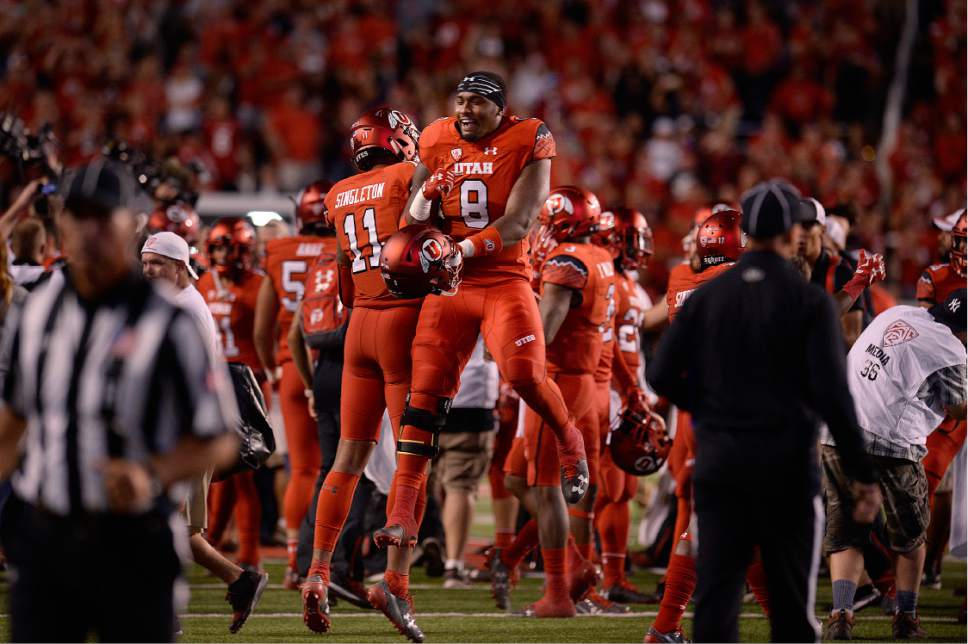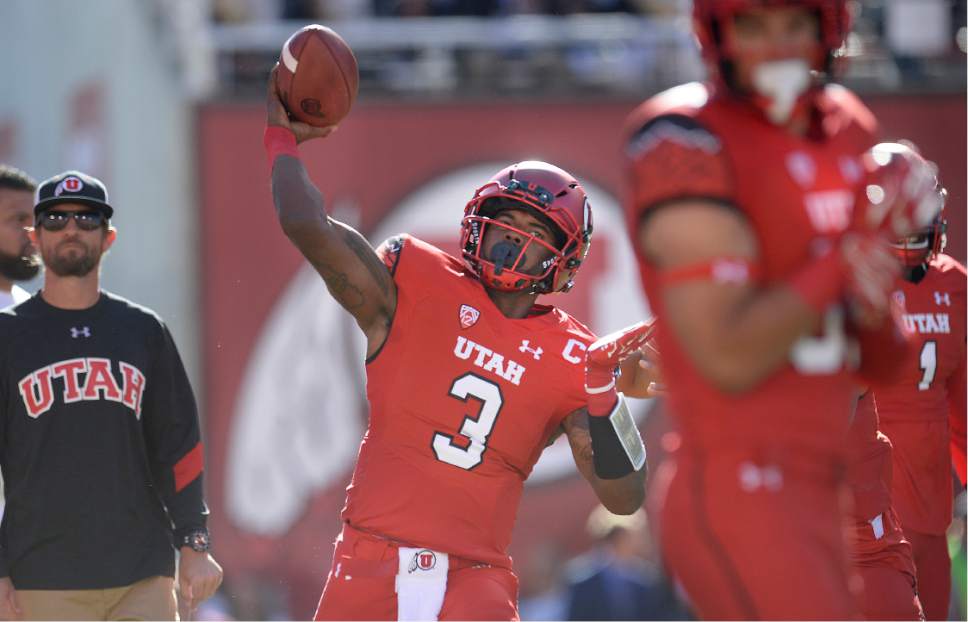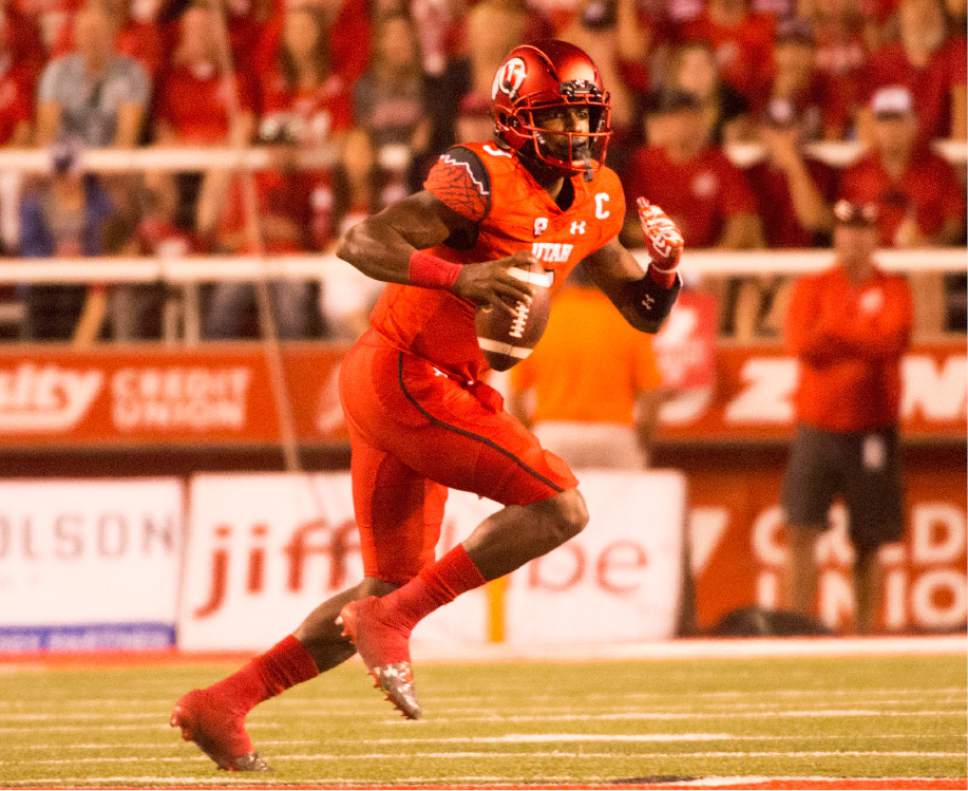This is an archived article that was published on sltrib.com in 2017, and information in the article may be outdated. It is provided only for personal research purposes and may not be reprinted.
March Madness? Kyle Whittingham acts like he's never heard of it.
"I've got tunnel vision," he said this week. "I think everyone's eager to get on the field and get going."
It already is spring football season for the Utes, which brings a kind of madness all its own.
Utah will start installing a new offense with a new coordinator while replacing a ton of departing talent in the trenches and in the secondary starting Thursday afternoon. After signing one of his best classes, Whittingham acknowledges a lot of position battles won't be fully decided until fall, but it's a time when Utah will have to start determining who are the big playmakers on offense and defense. A lot of it could do with who can shorten the learning curve as offensive coordinator Troy Taylor takes the helm.
"Those guys gotta come together," Whittingham said. "That's one of the priorities of spring. We think we really helped ourselves with recruiting, but we've got to reload, particularly on the offensive line and the secondary."
Here are the big questions going into spring:
How will the passing game transplant take, and who leads it?
Welcome to the Troy Taylor era. Everything could change.
Taylor has a mandate from above to install his offense as he sees fit. While that includes some of Utah's current terminology, it involves a new way of processing reads, of throwing more, of guys being responsible for getting open. Taylor has no loyalties to any player on the current roster, although he has acknowledged Troy Williams' playing experience likely gives him a slight edge over his competitors. Tyler Huntley likely will get about an even share of reps with Williams. Alabama transfer Cooper Bateman is the wild card in all of this.
We'll likely see early just how quick the learning curve is. Taylor says his offense is easy to learn and execute. It still includes some of Utah's formations and spread concepts. But with a new set of terminology, a new way of doing things and new coaches in the mix, how will the players take to the changes? Does the revolution really take root with the current roster?
Who is on the offensive line?
Whittingham calls this "one of the priorities" of spring — figuring out who will take over for the four offensive line starters who went to the NFL Combine.
Right now, Salesi Uhatafe is the only returner, and the soft-spoken guard will have to replace some of the best vocal veterans Utah has had under Whittingham. Injury sidetracked Lo Falemaka from clinching a starting center role last year. Jackson Barton, once the top-graded prep in the state, has a make-or-break spring ahead after getting a few starts last year.
Other once-touted recruits, including Darrin Paulo and Johnny Capra, have their chance to deliver on their promise. It hurts Utah that junior college product Jordan Agasiva, who is considered a serious competitor to start this fall, isn't at school early, but highly regarded (and former Paulo teammate) Orlando Umana will have a shot to show what he can do.
Who emerges as a receiving target?
It's going to be a twofold journey for Utah, which theoretically will see more three- and four-receiver sets in the new offense but hasn't bowled over opponents with receiver play. There were some steps forward last year, and returners Raelon Singleton and Saiosi Wilson offer size and speed, while slot man Demari Simpkins had a bit of a breakout in the Foster Farms Bowl.
It speaks to Utah's incoming class, which has some highly rated receivers, that Whittingham is comfortable swapping two receivers, Tyrone Smith and Caleb Repp, to defense. So this battle in no way will be decided by spring's end. But others down the depth chart — think Kyle Fulks, Samson Nacua, early enrollee Tyquez Hampton and running back-turned-receiver Troy McCormick — will have an opportunity to build confidence and make plays in the new offense, getting a head start on the newcomers.
Does the secondary reload or rebuild?
Arguably the toughest group to replace is the defensive backfield, which loses a star in Marcus Williams and a ton of experience as seniors left. Getting back Chase Hansen is a huge asset, but he's basically the one man returning with significant starting experience.
The Utes hope JuCo early enrollee Corrion Ballard is the answer for Williams, who was a tremendous ballhawk and run stopper.
Inexperience reigns on the edges. It'll be Julian Blackmon and Terrell Burgess, who played some last year, getting more reps, as well as Tyrone Smith converting from receiver. Nygel King and Boobie Hobbs are others to watch, but these battles will heat up significantly when Utah brings in a class with multiple four-star defensive backs.
Does Sack Lake City have a new mayor?
There's some exciting returning talent on the defensive line. Filipo Mokofisi and Lowell Lotulelei (injured for the spring) are expected to man the front next fall, while Bradlee Anae, Chris Hart and Leki Fotu — all of whom got time last season — will be in the mix as well. Maxs Tupai and receiver-turned-end Caleb Repp also figure into the rotation as ends.
The future of the defensive line looks strong, but the biggest thing Utah will miss there is the pass-rushing capability of Hunter Dimick and Pita Tauemoepenu. Dimick cemented his legacy at Utah by becoming the program's all-time leader in sacks, totaling 14.5 in his senior season. The returning leader is Mokofisi with five quarterback takedowns last season, but he figures to play less defensive end than he did last season. Utah needs a new sack artist to emerge.
Twitter: @kylegoon









